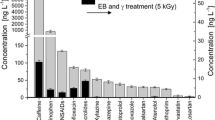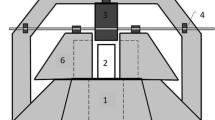Abstract
According to the basic principle of wastewater treatment by irradiation technology, the electron beam accelerator (EB) was used to treat oxytetracycline pharmaceutical wastewater. The radiolysis rate of organic substances under different conditions were discussed. The results showed that an irradiation dose was less than 20 kGy, the radiolysis rate and the absolute amount of organic substances were the largest, and the dose of 20–50 kGy, which were the lowest due to the polymerization reaction. The radiolysis rate decreased while the dose was more than 50 kGy. The addition of hydrogen peroxide within 15 mmol/L when a wastewater pH was 5–7 contributed to the radiolysis of organic substances.






Similar content being viewed by others
References
Bailey VL, Smith JL, Bolton H (2003) Novel antibiotics as inhibitors for the selective respiratory inhibition method of measuring fungal: bacterial ratios in soil. Biol Fert Soils 38(3):154–160. https://doi.org/10.1007/s00374-003-0620-7
Tamtam F, Mercier F, Lebot B (2008) Occurrence and fate of antibiotics in the Seine River in various hydrological conditions. Sci Total Environ 393(1):84–95. https://doi.org/10.1016/j.scitotenv.2007.12.009
Schmitt H, Martinali B, Vanbeelen P (2006) On the limits of toxicant-induced tolerance testing: cotolerance and response variation of antibiotic effects. Environ Toxicol Chem 25(7):1961–1968. https://doi.org/10.1897/05-149R.1
Peak N, Knapp CW, Yang RK (2007) Abundance of six tetracycline resistance genes in wastewater lagoons at cattle feedlots with different antibiotic use strategies. Environ Microbiol 9(1):143–151. https://doi.org/10.1111/j.1462-2920.2006.01123.x
Ma Y, Sun YX, Chen JJ (2010) Advance in ecological environment impact of veterinary drug residues. Chin Vet Sci 40(06):650–654
Pikaev AK (2001) Mechanism of the radiation purification of polluted water and wastewater. High Energy Chem 35(5):346–351. https://doi.org/10.1023/A:1011926905064
Pikaev AK, Shubin VN (1984) Radiation treatment of liquid wastes. Radiat Phys Chem 24(1):77–97. https://doi.org/10.1016/0146-5724(84)90009-8
Kurucz C (1995) The Miami electron research facility: a large scale wastewater treatment application. Radiat Phys Chem 45(2):299–308
Borrely SI, Cruz AC, Del Mastro NL (1998) Radiation process of sewage and sludge: a review. Prog Nucl Energy 33(1–2):3–21
Sampa MHO (2009) Ongoing research in Brazil using electron beam liquid waste treatment, status of industrial scale radiation treatment of wastewater and its future. In: Proceedings of a consultants meeting held in Daejeon, pp 29–36. http://www.iaea.org/publications
Kim SM, Han B (2006) Application of high powder electron accelerator in wastewater treatment. In: Russia Proceedings of RuPAC, Novosibirsk. http://pdfs.semanticscholar.org/
Wang T, Waite TD, Kurucz C (1994) Oxidant reduction and biodegradability improvement of paper mill effluent by irradiation. Water Res 28(1):237–241. https://doi.org/10.1016/0043-1354(94)90139-2
IAEA (2016) Radiation technology for cleaner products and processes. IAEA-TECDOC, Vienna, p 1786
Wang JL, Chu LB (2017) Research progress of ionizing irradiation technology on wastewater treatment. Chin J Environ Eng 11(2):653–672. https://doi.org/10.12030/j.cjee.201611148
APHA (1998) The standard methods for the examination of water and wastewater, 20th edn. American Public Health Association, Washington, DC
Mozumder A (1999) Fundamentals of radiation chemistry. Academic Press, California
Wu JL, Qi SC (1993) Radiation chemistry. Atomic Energy Press, Beijing
Peng J, Hao Y, Wei GS (2015) Radiation chemistry basics tutorial. Peking University Press, Beijing
Wangwang S, Dong J, Xuyang W et al (2021) Technical study on COD degradation of oxytetracycline pharmaceutical wastewater by electron beam irradiation technology. Ind Water Treat 41(2):80–83. https://doi.org/10.11897/iwt.2020-0351
Zheng B, Zheng Z, Zhang J (2012) Degradation kinetics and by-products of naproxen in aqueous solutions by gamma irradiation. Environ Eng Sci 29(6):86–391. https://doi.org/10.1089/ees.2010.0215
Getoff N (1996) Radiation-induced degradation of water Pollutants-State of the art. Radiat Phys Chem 47(6):581–593. https://doi.org/10.1016/0969-806X(95)00059-7
Zhou JX, Wu MH, Xu G (2010) E-beam degradation of thiamphenicol and florfenicol. Nucl Sci Tech 21:334–338. https://doi.org/10.13538/j.1001-8042/nst
Acknowledgements
This research was supported by China National Uranium Co., Ltd. The authors deeply appreciate their financial support.
Funding
The research content of this paper is funded by China Nuclear Uranium Co., LTD. This research is an independent research project, and the funding number is YKYHBZ2019-04.
Author information
Authors and Affiliations
Corresponding author
Additional information
Publisher's Note
Springer Nature remains neutral with regard to jurisdictional claims in published maps and institutional affiliations.
Rights and permissions
Springer Nature or its licensor (e.g. a society or other partner) holds exclusive rights to this article under a publishing agreement with the author(s) or other rightsholder(s); author self-archiving of the accepted manuscript version of this article is solely governed by the terms of such publishing agreement and applicable law.
About this article
Cite this article
Ji, D., Song, W., Liu, X. et al. Discussion on the radiolysis rate of organic substances in oxytetracycline pharmaceutical wastewater. J Radioanal Nucl Chem 332, 2231–2237 (2023). https://doi.org/10.1007/s10967-023-08836-1
Received:
Accepted:
Published:
Issue Date:
DOI: https://doi.org/10.1007/s10967-023-08836-1




